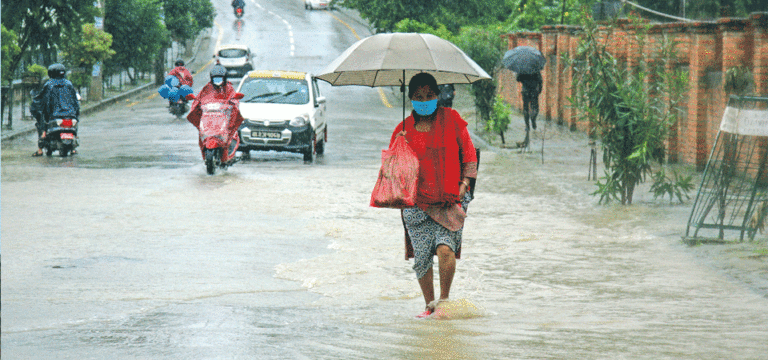
The Meteorological Forecasting Division (MFD) has predicted that the monsoon is likely to be delayed by a week this year. Generally, the monsoon season begins from June 10 and lasts till September 23 in Nepal.
Pratibha Manandhar, a Senior Meteorologist at the MFD has said that the monsoon is likely to arrive in Nepal by June 13 or slightly delay. “The monsoons should have reached the western coast of India by now but since it has been delayed it is possible that it could be delayed by around a week in Nepal too,” She said.
Monsoon arrived in two days lately in 2019 and 2020. But in 2018, it had begun two days earlier than the normal onset date of June 10.
Meanwhile, the Department of Hydrology and Meteorology (DHM) has forecasted more than average rainfall in Nepal for this year. According to a report published by the DHM, the Provinces of Sudurpaschim, Karnali, Gandaki, and Bagmati along with the Mid-Hills region and the Himalaya region of Province one is expected to receive about 35 – 65 per cent more than average rainfall. Similarly, the Terai region of Lumbini, Gandaki, Bagmati, and the western region of Province 2 is expected to receive average rainfall ranging from 35 – 45 per cent within the average amount.
Finally diverging from the trend the Terai region of Province one and the eastern region of Province two is expected to receive less than average rainfall ranging between 35 – 45 per cent less than the average amount of rainfall.
“The regions that have rainfall ranging from 35 – 65 per cent above average means that, within this region, some places have the probability of receiving higher than average rainfall by only 35 percent whereas some places may receive above-average rainfall by more than 60 or at 65 per cent.” The Chief of Climate Analysis Section of the DHM, Dr. Indira Kadel said.
Eighty percent of all the rain in Nepal is received during the monsoon (June-September). The average amount of rainfall throughout the country has been estimated to be approximately 1600 mm although this varies from place to place. Such as Pokhara receives approximately 3,345 mm of rain annually and Mustang only receives less than 300 mm of rainfall every year.
Meteorologist at the MFD Samir Shrestha has said that due to heavy rainfall throughout the country there are higher chances for floods and landslides to take place.
“Nepal has already been receiving pre-monsoon rains and the recent Cyclone Yaas which devastated Eastern India has also brought significant rainfall to Eastern parts of Nepal. This coupled with a higher amount of rainfall significantly increases the risk for flooding and landslides,” Shrestha said.
The Undersecretary of the National Emergency Operation Centre (NEOC) under the Ministry of Home Affairs, Dil Kumar Tamang, said that a flood can only be predicted within 72 hours.
Source : THE RISING NEPAL,





